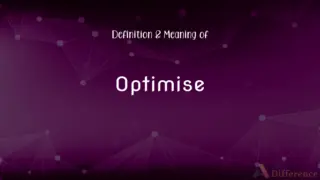Steadying vs. Moderating — What's the Difference?
By Tayyaba Rehman & Maham Liaqat — Updated on March 4, 2024
Steadying involves stabilizing or making something less shaky, while moderating refers to reducing extremities or making less intense.

Difference Between Steadying and Moderating
Table of Contents
ADVERTISEMENT
Key Differences
Steadying is primarily about providing support or balance to prevent something from shaking, moving, or changing abruptly. It focuses on maintaining a consistent state or pace in various contexts, such as steadying a camera for a clear shot or steadying oneself during a hike. Moderating, on the other hand, involves adjusting the level, intensity, or extremeness of something to make it more moderate. It's about finding a middle ground or reducing excesses, such as moderating a discussion to ensure all voices are heard or moderating consumption to avoid overindulgence.
Steadying is often used in physical or emotional contexts where stability is desired. For example, steadying a ladder to ensure safety or steadying one's emotions in a stressful situation. Moderating, however, is frequently applied in situations requiring judgment or control over intensity, such as moderating the temperature in a room or moderating the tone of a debate. This distinction highlights steadying's focus on maintaining balance and moderating's role in managing levels or intensities.
Steadying can involve physical support or techniques to maintain or return to a state of balance, suggesting an immediate action to prevent instability or loss of control. In contrast, moderating often involves a process or approach to gradually adjust or regulate conditions, aiming for a long-term balance or sustainability. For instance, steadying a boat in rough waters requires immediate action to prevent capsizing, while moderating water usage in a household involves planning and consistent effort.
The impact of steadying is typically direct and observable, as it aims to immediately address instability or fluctuation. The effects of moderating, however, may be more gradual and not as immediately apparent, focusing on preventing future extremes or maintaining a balanced state over time. Steadying a nervous performer before going on stage has an immediate calming effect, whereas moderating the pace of a project involves ongoing adjustments to ensure timely completion without burnout.
The terminology itself reflects the different focuses of these actions. "Steadying" conveys a sense of immediate support and balance, often in response to a specific instability or potential for fluctuation. "Moderating," however, suggests a broader role in managing, controlling, or adjusting conditions, levels, or behaviors to avoid extremes and maintain a moderate or balanced state.
ADVERTISEMENT
Comparison Chart
Primary Focus
Stabilizing or balancing
Reducing intensity or extremeness
Application
Physical/emotional stability
Control over intensity/levels
Action
Immediate support to prevent instability
Gradual adjustment for long-term balance
Impact
Direct and observable
Gradual and focused on prevention
Terminology
Conveys support and balance
Suggests management and adjustment
Compare with Definitions
Steadying
Can refer to calming emotions or nerves.
Taking deep breaths helped in steadying her nerves before the presentation.
Moderating
Involves judgment or control over conditions.
Moderating his diet helped him improve his health significantly.
Steadying
Often involves physical actions to prevent movement.
He steadied the boat as they climbed aboard.
Moderating
Adjusting the intensity or level to make less extreme.
The teacher moderated the classroom discussion to ensure all students participated.
Steadying
Providing support or balance to maintain stability.
The photographer was steadying his camera on a tripod for a sharp image.
Moderating
Often requires ongoing effort or planning.
Moderating the pace of the project prevented team burnout.
Steadying
Used in contexts requiring immediate stability.
She steadied herself against the railing to avoid falling.
Moderating
Aims for sustainability and prevention of excesses.
Moderating the use of natural resources is vital for environmental conservation.
Steadying
Aims for immediate stabilization or balance.
Steadying the ladder ensured a safe working environment for painting.
Moderating
Focuses on long-term balance and avoiding extremes.
Moderating temperatures in the house saved energy and reduced bills.
Steadying
Firm in position or place; fixed.
Moderating
Being within reasonable limits; not excessive or extreme
A moderate price.
Steadying
Free or almost free from change, variation, or fluctuation; uniform
A steady increase in value.
A steady breeze.
Moderating
Not violent or subject to extremes; mild or calm; temperate
A moderate climate.
Steadying
Not easily excited or upset
Steady nerves.
Moderating
Of medium or average quantity or extent.
Steadying
To make or become steady.
Moderating
Of limited or average quality; mediocre.
Steadying
The process of making something steady; stabilization.
Moderating
Opposed to radical or extreme views or measures, especially in politics or religion.
Steadying
Causing to become steady;
Had a steadying effect on her nerves
Moderating
To cause to be less extreme, intense, or violent.
Moderating
To act as a moderator.
Moderating
Lessening in intensity or strength. Opposite of intensifying.
Moderating
Lessening in intensity or strength
Common Curiosities
Is steadying always a physical action?
While often physical, steadying can also refer to emotional or psychological support to maintain stability.
How can steadying be crucial in sports or physical activities?
In sports, steadying can prevent injuries by ensuring proper balance and control during movements.
What is the main difference between steadying and moderating?
Steadying focuses on providing immediate stability or balance, while moderating is about adjusting levels or intensity to avoid extremes.
Can steadying apply to emotional situations?
Yes, steadying can refer to calming one's emotions or nerves in stressful situations.
How does moderating contribute to sustainability?
Moderating involves making adjustments to prevent overuse or excess, contributing to long-term sustainability and balance.
What role does moderating play in discussions or debates?
Moderating ensures a balanced discussion, allowing all voices to be heard and preventing any one viewpoint from dominating.
What is the importance of moderating in environmental conservation?
Moderating consumption and resource use is crucial for reducing environmental impact and ensuring resources are available for future generations.
How does moderating affect personal health?
Moderating diet, exercise, and stress levels can lead to improved health and well-being.
What tools or devices assist in steadying physical objects?
Tools like tripods, stabilizers, and braces help in steadying objects or equipment for precision and safety.
Can steadying be a temporary solution?
Yes, steadying often provides immediate but temporary stability, requiring further actions for long-term stability.
Why is steadying important in photography or videography?
Steadying the camera is essential for clear, sharp images or smooth video footage, preventing blur or shake.
Can steadying be applied to financial markets?
Yes, regulatory actions or policies can help in steadying financial markets during volatility.
What is the role of a moderator in online forums?
A moderator adjusts the flow of discussion, ensuring respectful dialogue and adherence to forum rules, effectively moderating the conversation.
How does moderating temperature in a building contribute to energy efficiency?
Moderating temperature through thermostats or insulation can reduce energy consumption and lower utility bills.
How can moderating improve workplace productivity?
By moderating workload and stress, it's possible to prevent burnout and maintain consistent productivity.
Share Your Discovery

Previous Comparison
Conductor vs. Driver
Next Comparison
Left vs. LetAuthor Spotlight
Written by
Tayyaba RehmanTayyaba Rehman is a distinguished writer, currently serving as a primary contributor to askdifference.com. As a researcher in semantics and etymology, Tayyaba's passion for the complexity of languages and their distinctions has found a perfect home on the platform. Tayyaba delves into the intricacies of language, distinguishing between commonly confused words and phrases, thereby providing clarity for readers worldwide.
Co-written by
Maham Liaqat











































